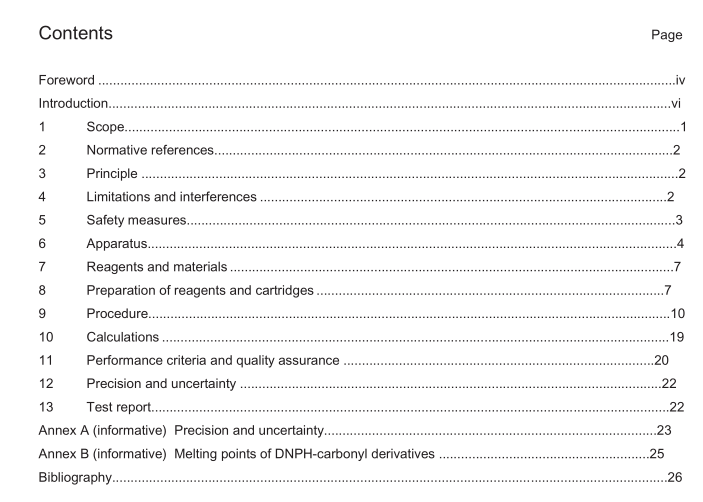BS ISO 16000-3 pdf download

BS ISO 16000-3 pdf download Indoor air Part 3: Determination of formaldehyde and other carbonyl compounds in indoor air and test chamber air — Active sampling method
2 Normative references
The following referenced documents are indispensable for the application of this document. For dated references, only the edition cited applies. For undated references, the latest edition of the referenced document (including any amendments) applies. ISO/IEC 17025, General requirements for the competence of testing and calibration laboratories
3 Principle
The method specified in this part of ISO 16000 involves drawing air through a cartridge containing silica gel coated with 2,4-dinitrophenylhydrazine (DNPH) reagent. The principle of the method is based on the specific reaction of a carbonyl group with DNPH in the presence of an acid to form stable derivatives according to the reaction shown in Figure 1. The DNPH derivatives are analysed for the parent aldehydes and ketones utilizing high performance liquid chromatography (HPLC) with UV detection or diode array detection. The detection has been extended to other carbonyl compounds that can be determined as outlined in 9.3.5.
This part of ISO 16000 instructs the user on how to prepare sampling cartridges from commercially available chromatographic grade silica gel cartridges by the application of acidified DNPH to each cartridge. Alternatively, pre-coated DNPH silica gel cartridges are available and are recommended since they are generally more uniform in manufacture and possess lower blank levels. However, if commercial cartridges are used, they shall be demonstrated to meet the performance criteria of this part of ISO 16000. Another advantage of commercial cartridges is that they are available with larger particle size silica gel that results in a lower pressure drop across the cartridge. These low pressure drop cartridges may be more suitable for sampling air using battery-powered personal sampling pumps.
4 Limitations and interferences
4.1 General The sampling flow rate specified in this part of ISO 16000 has been validated for sampling rates up to 1,5 l/min. This flow rate limitation is principally due to the high pressure drop (>8 kPa at 1,0 l/min) across the user-prepared silica gel cartridges, which have particle sizes of 55 µm to 105 µm. These cartridges are not generally compatible with battery-powered pumps used in personal sampling equipment (e.g. those used by industrial hygienists). The solid-sorbent sampling procedure is specific for sampling and analysis of formaldehyde. Interferences in this method are caused by certain isomeric aldehydes or ketones that may be unresolved by the HPLC system when analysing for other aldehydes and ketones. Any organic compounds that have the same retention times and significant absorbance at 360 nm as the DNPH derivative of formaldehyde interfere. Such interferences can often be overcome by altering the separation conditions (e.g. using alternative HPLC columns or mobile phase compositions).
Formaldehyde contamination of the DNPH reagent is a frequently encountered problem. The DNPH shall be purified by multiple recrystallizations in UV-grade acetonitrile (ACN). Recrystallization is accomplished, at 40 °C to 60 °C, by slow evaporation of the solvent to maximize crystal size. Impurity levels of carbonyl compounds in the DNPH are determined prior to use by HPLC and should be less than 0,15 µg per cartridge. Exposure of the DNPH-coated sampling cartridges to direct sunlight may produce artefacts and should be avoided [17] . Acrolein and crotonaldehyde may not be accurately quantified by the method. Inaccurate results for these compounds may result from the formation of multiple derivative peaks and the instability of the peak ratios [18] . Nitrogen dioxide reacts with DNPH. High concentrations of NO 2 (e.g. for gas cooking stoves) may cause problems as the retention time of the DNPH derivative may be similar to that of the DNPH formaldehyde derivative, depending on the HPLC column and the parameters [13][14][19] .
4.2 Ozone interference If there is suspicion that abnormally high levels of ozone are present in the area being sampled (e.g. from office copiers), special care should be exercised. Ozone has been shown to interfere negatively by reacting with both DNPH and its derivatives (hydrazones) in the cartridge [20] . The extent of interference depends on the temporal variations of both the ozone and the carbonyl compounds and the duration of sampling. Significant negative interference from ozone has been observed even at concentrations of formaldehyde and ozone typical of clean ambient air (2 µg/m 3 and 80 µg/m 3 , respectively) [19] . The presence of ozone in the sample is readily inferred upon analysis by the appearance of new compounds with retention times shorter than that of the hydrazone of formaldehyde. Figure 2 shows chromatograms of samples of a formaldehyde- spiked air stream with and without ozone.









